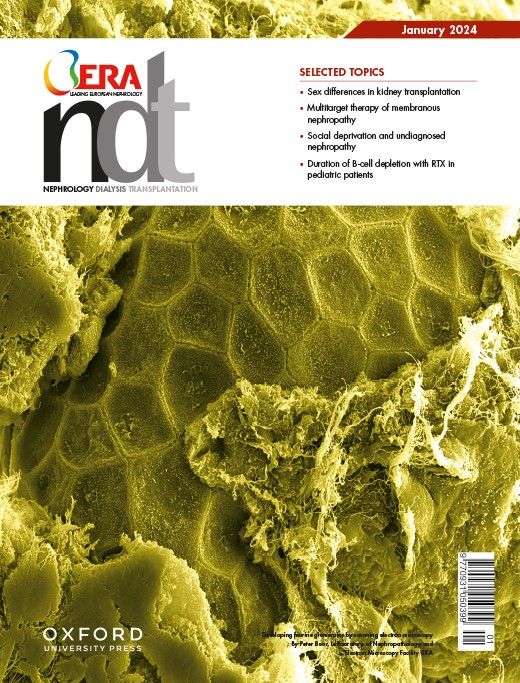Biology of calcium homeostasis regulation in intestine and kidney
IF 4.8
2区 医学
Q1 TRANSPLANTATION
引用次数: 0
Abstract
Calcium (Ca2+) is an essential divalent cation involved in many bodily functions including bone composition, cell growth and division, blood clotting, and muscle contraction. The bone, intestine, and kidneys are important to the maintenance of Ca2+ homeostasis. Ninety-nine percent of body Ca2+ is stored in the skeleton as hydroxyapatite. The small, and to a lesser extent the large intestine absorbs Ca2+ from the diet. Once in the circulation, Ca2+ is filtered by the glomerulus and the majority, >95%, is reabsorbed along the nephron. The remainder is excreted in the urine. Two general (re)absorptive pathways contribute to the vectorial transport of Ca2+ across renal and intestinal epithelia: 1) a paracellular pathway, which is reliant on claudins in the tight junction of epithelium and the electrochemical gradient and 2) a transcellular pathway, which requires different influx, intracellular buffering/shuttling and basolateral efflux mechanisms, to actively transport Ca2+ across the epithelial cell. Blood Ca2+ levels are maintained by hormones including parathyroid hormone, 1,25-dihydroxyvitamin D3, fibroblast growth factor 23 and through effects of Ca2+−sensing receptor (CaSR) signaling. Disruption of Ca2+ homeostasis can result in altered blood Ca2+ levels and/or hypercalciuria, the latter is a phenomenon closely linked to the formation of kidney stones. Genetic alterations affecting renal Ca2+ handling can cause hypercalciuria, an area of expanding investigation. This review explores the molecular mechanisms governing Ca2+ homeostasis by the intestine and kidneys and discusses clinical aspects of genetic disorders associated with Ca2+-based kidney stone disease.肠道和肾脏中的钙平衡调节生物学
钙(Ca2+)是人体必需的二价阳离子,参与多种身体功能,包括骨骼组成、细胞生长和分裂、血液凝结和肌肉收缩。骨骼、肠道和肾脏对维持 Ca2+ 的平衡非常重要。体内 99% 的 Ca2+ 以羟磷灰石的形式储存在骨骼中。小肠从食物中吸收 Ca2+,其次是大肠。进入血液循环后,Ca2+ 经肾小球过滤,大部分(95%)沿肾小管被重吸收。剩余部分则随尿液排出体外。肾脏和肠道上皮细胞对 Ca2+ 的矢量转运一般有两种(再)吸收途径:1)细胞旁途径,依赖于上皮细胞紧密连接处的laudins 和电化学梯度;2)跨细胞途径,需要不同的流入、细胞内缓冲/关闭和基底侧流出机制,才能积极地将 Ca2+ 转运到上皮细胞。血液中的 Ca2+ 水平由激素维持,包括甲状旁腺激素、1,25-二羟维生素 D3、成纤维细胞生长因子 23 以及 Ca2+ 感应受体(CaSR)信号的影响。Ca2+ 平衡的破坏会导致血液 Ca2+ 水平的改变和/或高钙尿症,后者与肾结石的形成密切相关。影响肾脏 Ca2+ 处理的基因改变可导致高钙尿症,这一研究领域正在不断扩大。本综述探讨了肠道和肾脏调节 Ca2+ 平衡的分子机制,并讨论了与基于 Ca2+ 的肾结石疾病相关的遗传疾病的临床方面。
本文章由计算机程序翻译,如有差异,请以英文原文为准。
求助全文
约1分钟内获得全文
求助全文
来源期刊

Nephrology Dialysis Transplantation
医学-泌尿学与肾脏学
CiteScore
10.10
自引率
4.90%
发文量
1431
审稿时长
1.7 months
期刊介绍:
Nephrology Dialysis Transplantation (ndt) is the leading nephrology journal in Europe and renowned worldwide, devoted to original clinical and laboratory research in nephrology, dialysis and transplantation. ndt is an official journal of the [ERA-EDTA](http://www.era-edta.org/) (European Renal Association-European Dialysis and Transplant Association). Published monthly, the journal provides an essential resource for researchers and clinicians throughout the world. All research articles in this journal have undergone peer review.
Print ISSN: 0931-0509.
 求助内容:
求助内容: 应助结果提醒方式:
应助结果提醒方式:


